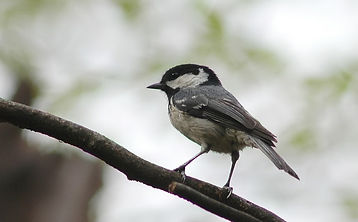
ふるもりの野鳥
The birds in Hatto Furusato no Mori
シジュウカラ Japanese tit
高い木などに止まり、「ツーピツーピ」「ツィピーツィピーツィピー」同じさえずりを数回繰り返す。鳴き声の組み合わせを変えて仲間に警告するといった言語能力を持つとして、研究対象になっています。
Perching on tall trees, they repeatedly chirp "tsu-pi tsu-pi" or "tsi-pi tsi-pi tsi-pi" several times. They are being studied for their linguistic abilities, which include the capability to warn their peers by changing combinations of their calls.
カケス Eurasian Jay
「ジェー、ジェー」としわがれた声で鳴き英語名の『Jay』はこの鳴き声に由来そうです。また他の鳥の鳴き声や物音を真似するのが巧く、林業のチェーンソーや枝打ち、木を倒す時の作業音を再現することもあるそうです。ふるもりでうるさい声はこの子です。
The hoarse cry of "jay, jay" likely inspired the English name "Jay" for this bird. Additionally, they are skilled mimics of other birds' calls and various sounds, sometimes even reproducing the sounds of forestry activities like chainsaws, branch cutting, and the noise of trees being felled. If you hear a noisy voice in the forest, it's probably this bird.
ヒガラ Coal Tit
シジュウカラの仲間としては日本で最小。頬が白いことと喉の三角形の黒斑が特徴です。「ツピン ツピン・・・」とか、「チペ チペ チペ・・・」 とか高い声で、早口で繰り返し、さえずります。
As the smallest member of the tit family in Japan, it is characterized by white cheeks and a triangular black patch on its throat. Its chirps consist of high-pitched, rapid repetitions such as "tsupin tsupin..." or "chipe chipe chipe..."
ツツドリ Oriental Cuckoo
ホトトギスの仲間で「ポポッ ポポッ」と鼓を打つような声で鳴き、紙筒の口を叩く音に似ているとして、筒鳥と呼ばれています。
The bird known as the Toad lily, a member of which is noted for its call resembling the sound of a drumbeat with "popo popo," is referred to as the tsuchidori, or "tube bird," due to the sound it makes striking the mouth of a paper cylinder.
コノハズク Scops owl
コノハズクも八東ふる里の森の名物です。園内に設置した巣箱に複数のつがいが毎年営巣します。 7月初めから中旬にかけて巣箱のライトアップを行っています。鳴き声は「ブッポウソウ」声のブッポウソウと呼ばれています。
The Scops Owl is also a specialty of Hatto Furusato no Mori. Several pairs nest each year in nesting boxes installed within the park. From early to mid-July, the nesting boxes are illuminated. Their call is known as "buppo-usou"
アカショウビン Ruddy Kingfisher
八東ふる里の森に訪れる皆様の一番人気がアカショウビンです。 5月始めに飛来して園内や周辺で繁殖します。 朝4:00から6:00、日暮れにかけてよく園内で鳴きます。
The most popular bird for visitors to Hatto Furusato no Mori is the Ruddy Kingfisher. They arrive around early May and breed within the park and its surroundings. They are often heard singing within the park from 4:00 to 6:00 in the morning and during dusk.
オオコノハズク Sunda Scops-owl
コノハズクに並んで人気があるのがオオコノハズクです。オオコノハズクも園内の巣箱に営巣します。肉食でネズミやモモンガ、時には天然記念物の「ヤマネ」も捕食しています。6月中旬から下旬にかけてライトアップします。給餌の姿は迫力があります。
Alongside the Scops Owl, another popular bird at Yato Furusato no Mori is the Ural Owl . The Ural Owl also nests in the park's nesting boxes. It is a carnivorous bird that preys on mice, flying squirrels, From mid to late June, there is illumination to observe them, and their feeding behavior is quite impressive.
アオバズク Blue owl
黄色の目が印象的なアオバズクは雛が孵ると親鳥が昼間巣を見張っているので日中もよく見かけます。ここ数年園内のオオコノハズク用の巣箱に営巣しています。
The Northern Hawk Owl, with its striking yellow eyes, is often spotted during the day, especially when the chicks hatch and the parent birds watch over the nest. Over the past few years, they have been nesting in nesting boxes designated for tSunda Scops-owl within the park.
サンコウチョウ Paradise flycatcher
長い尻尾をもったサンコウチョウは杉林を好むので八東ふる里の森から5キロ道を下った杉林に営巣しています。園内では時折「ホイホイ」と鳴き声が聞こえます。
The Paradise flycatcher, known for its long tail, nests in cedar forests located about 5 kilometers downhill from Hatto Furusato no Mori, where it prefers cedar forests. Occasionally, its distinctive call of "hoi hoi" can be heard within the park.
ミゾゴイ Japanese Night Heron
ミゾゴイは環境省レッドリスト2015において絶滅危惧Ⅱ塁に、国際自然保護連合ではEN(野生での絶滅の非常に高い危険性に直面している)区分されています。世界の個体数は1000羽以下といわれています。八東ふる里の森では2022年に園内での営巣が確認されています。2023年は営巣は確認できませんでしたが、園内で見かけることができました。
The Japanese Night Heron is classified as Endangered (EN) by the International Union for Conservation of Nature (IUCN) and as Endangered II category on the Ministry of the Environment's Red List for 2015. The global population is estimated to be fewer than 1,000 individuals. In Yato Furusato no Mori, nesting was confirmed within the park in 2022. Although nesting was not confirmed in 2023, the birds were still observed within the park.
ハチクマ Blue woodpecker
ハチの巣を襲って幼虫を食べる 刺されても平気(?)なタフなクマタカです。絶滅危惧種として位置づけられています。警戒心が強く、人が見えると近づかないためなかなか見れない鳥ですが、ふるもりでは養蜂をしており餌となる蜂の巣があるため、時折観察されます。
The tough and fearless black kite attacks beehives to eat the larvae. Despite being stung, it remains unfazed (?). Classified as an endangered species, it is difficult to spot as it is cautious and keeps its distance from humans. However, in rural areas where beekeeping is common, it is occasionally observed because there are beehives, which serve as its food source.










_JPG.jpg)






